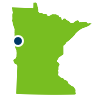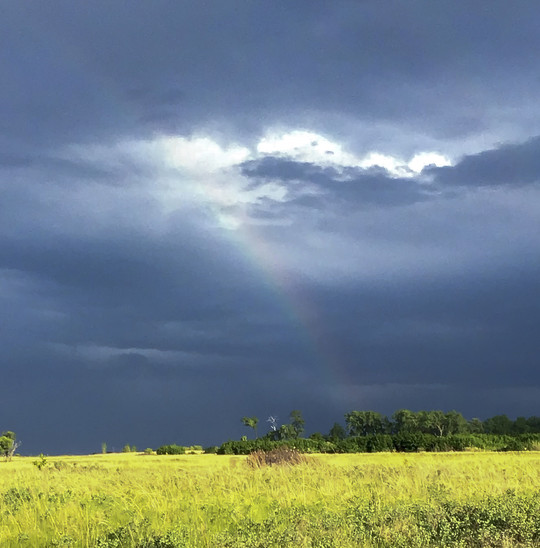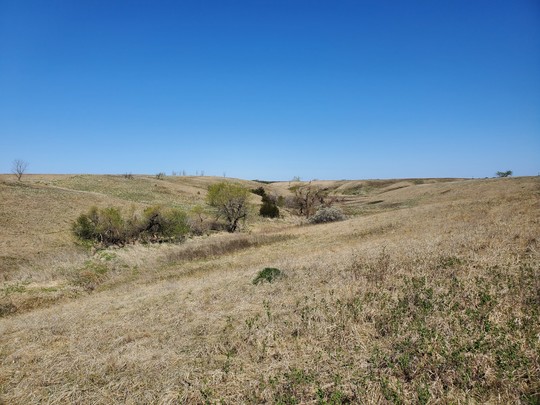A Crash Course in Wildflower Identification
Arika Preas, SNA Northeast Regional Naturalist
A Guide for Your Journey
Before you leave your house, you will want to properly arm yourself with a great plant guide. When choosing your guide make sure to choose one for the region you’ll be exploring. For example, a west coast specific guide will not be very helpful in Minnesota. Next, pick one organized in a way that is comfortable for you. Most flower guides are arranged by flower color or shape but more advanced ones may be organized by family and genus. Some classic go-to guides include Peterson, Newcomb’s and The Audubon Society guides. Online guides include Minnesota Wildflowers and the Seek app by iNaturalist.
Some Nitty Gritty of Plant ID
A professor once told me that “a scientist’s favorite pastime is to give everything a name.” What this means for you is that there is a lot of vocabulary when it comes to plant identification. Your guide should have a glossary that defines any terms that it uses. I will go over some of the basic flower terminology to get you started.
Let’s start with the basic flower shape. Your everyday, daisy-like flowers are aptly named regular flowers. When looking at these flowers you will want to pay attention to how many petals they have, as this can be very helpful information. Native phlox and invasive dame’s rocket (Hesperis matronalis) look very similar but phlox has five petals and dame’s Rocket only has four. Then you have the more unique bell and tubular flowers that will have their petals fused together to create their namesake shape. Irregular flowers, such as lady’s slipper orchids, have differently shaped petals on the same flower. Last but not least are indistinct flowers, these have no recognizable petals, such as Pussytoes’ flowers.
Some plants have distinct clusters of flowers. Depending on their arrangement, each type of cluster (called an inflorescence) has its own name. Umbels remind me of umbrellas. An example of this is the invasive Queen Anne’s lace (Daucus carota). Both spike and raceme inflorescences’ are made up of flowers attached along the length and to the end of the stem. The difference between them is that flowers in a raceme are attached to the stem via a stalk and spike flowers are attached directly with no stalk. If you find a flower that looks similar to a raceme but with multi-branching flower stalks, that is called a panicle. The flowers of larger golden rods like Canada goldenrod (Solidago candensis) or tall goldenrod (Solidago altissima), are arranged in a panicle inflorescence.
The terms I have defined so far are just a sample of flower terminology (and don’t get me started on leaf vocabulary where you have words like spathulate and oblanceolate) but this is a good beginning to get you started. Don’t worry, even if you only remember one word I went over, your skills have already grown. To this day I still use the glossary in the back of my field guides.
What is blooming now?
Below are a few flowers that may be blooming now. I have included their key identifying features using some of the vocabulary you just learned.
Yarrow (Achillea millefolium) at Oronoco Prairie SNA. A group of white, regular, five petal flowers in an umbel inflorescence with fern-like leaves. Photo © Terri Dugan, some rights reserved (CC-BY-NC) inaturalist.org/observations/54061643
Fireweed (Chamaenerion angustifolium) at Moose Mountain SNA. A group of pink, regular, four petal flowers in a raceme inflorescence with long and narrow leaves that have milky white midrib (center vein). Photo © Elizabeth McLaughlin, some rights reserved (CC-BY-NC) inaturalist.org/observations/53421413
Harebell (Campanula rotundifolia) at Iona’s Beach SNA. A group of purple, bell-shaped flowers in a raceme with heart-shaped basal leaves and linear stem leaves. Photo © naturegeek168, some rights reserved (CC-BY-NC) inaturalist.org/observations/53335928
Lead Plant (Amorpha canescens) at Mille Lacs Moraine SNA. A group of purple, tubular flowers in a spike with pinnately compound leaves (a leaf divided into smaller leaflets along a central stalk) covered in grey wooly hairs. Photo by David Minor.
Thimbleberry (Rubus parviflorus). A group of white, regular, five petal flowers in a panicle with large palmate lobed leaves (several lobes that radiate from one point). Photo by Michael Lee.
Back to top
Connect with Minnesota’s Wild Places ❤︎

Planning a visit to the great outdoors this month? We have hand-picked a list of SNA recommendations for visiting that have good access, nearby amenities, and some even have trails!


Site Highlight: Bluestem Prairie SNA
Paula J Comeau, Northwest Region SNA/Park Naturalist, with contributions from Charlotte Roy, Wildlife Research Scientist
Summer has arrived at the Bluestem Prairie SNA in Clay County MN, and the landscape is alive with sounds of birds and insects. In addition, color is brightening the landscape as the prairie flowers of 2021 have pushed through the litter of 2020 and are beginning to bloom. As this beautiful and tranquil space reminds us every year begins anew, let’s take a few minutes to reflect on how this large remnant of native prairie has survived the past to continue to inform and inspire the future.
|
A bumblebee on Large Beardtongue (Penstemon grandifloras) at Bluestem Prairie SNA. Photo by Paula Comeau.
This area of Clay County is part of the original homelands of the Dakota and Assiniboine people, and artifacts from pre-European settlement are regular finds for archeologists and anthropologists. As European settlers moved across North America, the area became an extension of John Henry Smyser and his wife Mary’s homestead. They allowed their pedigreed horses and cattle to graze the area that would become the SNA, which fortunately kept the area from being plowed and preserved the rich prairie plant and animal diversity.
As native prairies were lost to mining, agricultural, and urban expansion, a variety of people and organizations began to actively protect those that remained. Notably, The Nature Conservancy (TNC) and Department of Natural Resources of Minnesota (MN DNR) have developed a partnership to actively manage the remaining remnants and to restore critical areas back into native prairie at Bluestem Prairie and elsewhere in the state. In Clay County alone, The Nature Conservancy protects 6568 acres, including Bluestem Prairie SNA and the Blazing Star unit of Felton Prairie SNA. These sites are designated as SNAs by the MN DNR, but are owned and managed by The Nature Conservancy. MN DNR, Division of Parks and Trails at Buffalo River State Park, also owns and manages a small portion of the Bluestem Prairie Complex. These SNAs protect habitats for many threatened and endangered species, such as the Dakota Skipper Butterfly and, the species most people visit the Bluestem Prairie to see, the charismatic Greater Prairie-Chicken.
Bluestem Prairie attracts people from all walks of life every year to experience the “booming grounds” or lek sites of the Greater Prairie-Chicken. For those willing to brave the cold and early mornings of spring, TNC sets up viewing blinds for birders of all ages to watch males dance in hopes of impressing a female. Viewing the dance of the Greater Prairie-Chicken is becoming a rare opportunity as their specific habitat requirements become harder to find due to habitat loss.
Male and female greater prairie-chickens (Tympanuchus cupido) on the lek at Bluestem Prairie SNA. Photo by Carrol Henderson.
Greater Prairie-Chickens have co-existed with grazing animals on the prairie for generations, and much of their habitats are naturally managed through the presence of grazers. Since the removal of bison from the landscape, brush encroachment and invasive species are altering many remnant prairies. Bluestem is not immune from this encroachment. It has been many years since wild or domestic grazers have dominated the site. Historically, prescribed fire and invasive species management have been used to prevent encroachment on many SNAs. However, new research on the impacts of grazing may provide another tool for conserving natural spaces. It is the hope of multiple agencies that grazing will mimic the impacts of bison on the landscape and help keep the prairie healthy.
Currently, DNR Wildlife Researcher, Charlotte Roy, is working with biologists at TNC and US Fish and Wildlife Service (USFWS), as well as DNR Wildlife Managers to study the effects of conservation grazing on the reproductive success of Greater Prairie-Chickens. These birds are used as an indicator species for the tallgrass prairie because they need large areas of prairie with diverse heights and vegetation structure. If a prairie is diverse enough to support Prairie-Chickens, it should support other bird species with fewer habitat requirements. For this reason, Greater Prairie-Chickens were selected to evaluate wildlife responses to conservation grazing. This study utilizes conservation grazing on 10 sites, including Twin Valley SNA, and other properties managed by TNC, USFWS, and DNR. Researchers are assessing how Greater Prairie-Chickens use the grazed areas throughout the nesting and brood-rearing seasons to better understand how prairie chickens and grazers co-exist. Research projects such as this allow us to better understand how the prairie functioned in the past. This provides insight into how we can more effectively manage these areas in the future.
 |
Rainbow over Bluestem Prairie SNA. Photo by Paula Comeau.
As Bluestem moves into full summer bloom, its stunning natural beauty stands a testament to the impressive prairie landscape that once dominated the center of North America. Hopefully, with the efforts of many researchers and land managers, it will stand testament for many generations to come.
Back to top

Notes from Site Stewards
Site stewards monitor SNAs across Minnesota. Their observations provide valuable information to the SNA Program. Here are some interesting notes from recent reports.
- Site steward Diane Newberry has visited Mary Schmidt Crawford Woods SNA multiple times this season to remove invasive species and scout. In the April 26th week alone, Diane pulled garlic mustard for 14 hours. She admired blooming spring wildflowers and wildlife during her visits as well.
- New steward, Joe Grussing, made his first visit to Des Moines River SNA on May 5th and observations included invasive species present and site facilities condition. On a positive note, he did spot some round-headed bush clover on-site.
- Kristina Bourne, the site steward for Moose Mountain SNA, made several helpful observations on site conditions this season. She noted vegetation damage from snowmobiles, litter (including a Christmas tree), and management projects including scots pine removal and bee survey equipment.
-
Zumbro Falls Woods SNA stewards, Jack and Laura Isenor, visited the SNA on April 18th and inspected the boundary sign and other site conditions. They did some bird watching, and Jack, who wants to be a park ranger when he grows up, submitted a report on the ticks they found at the SNA. “They almost took over our body. And it was scary”, he noted. Though in the end, they “took them off”. Remember to check for ticks when you are out in nature this summer!
 |
Joe Grussing, the new steward for Des Moines River SNA, visited the site in May. Photo by Joe Grussing.
Thanks for all the work you do, SNA stewards!
Back to top

SNA Events
This summer we are excited to have several events lined up, both in-person and “self-guided!” Check out the SNA Events page for the most up-to-date event information.

|